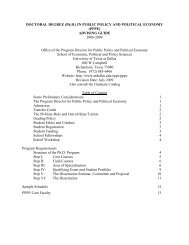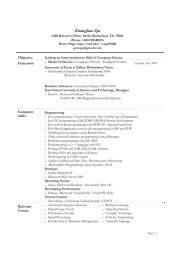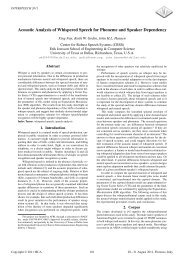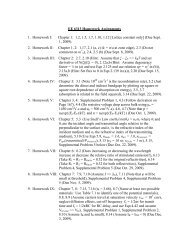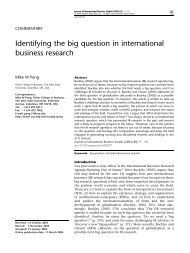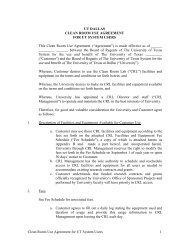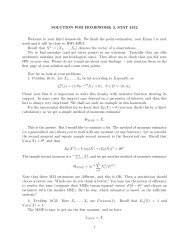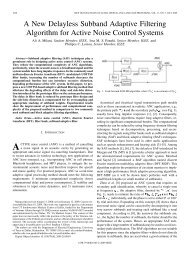Behind Intermediary Performance in Export Trade - The University of ...
Behind Intermediary Performance in Export Trade - The University of ...
Behind Intermediary Performance in Export Trade - The University of ...
Create successful ePaper yourself
Turn your PDF publications into a flip-book with our unique Google optimized e-Paper software.
studies may embrace two approaches.<br />
<strong>The</strong> first is to focus on the transaction as<br />
the unit <strong>of</strong> analysis, i.e., different export<br />
ventures with<strong>in</strong> the firm (Cavusgil and<br />
Zou, 1994). Another possibility is to employ<br />
a matched-sample design, compar<strong>in</strong>g<br />
and contrast<strong>in</strong>g the performance <strong>of</strong><br />
two samples <strong>of</strong> comparable exporters,<br />
one us<strong>in</strong>g export <strong>in</strong>termediaries and the<br />
other adopt<strong>in</strong>g a direct export strategy.<br />
Second, this study is vulnerable to all<br />
the standard criticisms leveled at survey<br />
research, which is the “most common<br />
method” <strong>in</strong> export strategy studies (Leonidou<br />
and Katsikeas, 1996: 531). To<br />
check for potential common method<br />
bias, we split the sample <strong>in</strong>to two halves<br />
by firm size and age, and ran the dependent<br />
variables from one half with the<br />
<strong>in</strong>dependent variables from another. <strong>The</strong><br />
results were similar to the f<strong>in</strong>d<strong>in</strong>gs reported,<br />
thus <strong>in</strong>dicat<strong>in</strong>g little common<br />
method variance. Despite potential social<br />
desirability bias, our qualitative<br />
work suggested that this <strong>in</strong>quiry, although<br />
prob<strong>in</strong>g proprietary <strong>in</strong>formation,<br />
was not thought to be so sensitive that<br />
would trigger a response to present the<br />
respondent firm <strong>in</strong> a favorable light. <strong>The</strong><br />
candor <strong>of</strong> the case study and pretest participants<br />
and the enthusiasm <strong>of</strong> the export<br />
community for our f<strong>in</strong>d<strong>in</strong>gs (Stroh,<br />
1996) seemed to support this view.<br />
Moreover, our case studies (Peng, 1998)<br />
allowed for an <strong>in</strong>dependent check on the<br />
plausibility <strong>of</strong> the f<strong>in</strong>d<strong>in</strong>gs.<br />
A further limitation is the lack <strong>of</strong> support<br />
for Hypothesis 2. One explanation is<br />
that the factor score for this construct<br />
was based on a two-item measure, which<br />
might not be able to fully capture the<br />
complexity <strong>of</strong> this construct. Moreover,<br />
it correlated 0.31 (p 0.05) with export<br />
knowledge (Table 2), which <strong>in</strong> a regression<br />
context, could cause it to be less<br />
significant due to its relative <strong>in</strong>clusion <strong>of</strong><br />
MIKE W. PENG, ANNE S. YORK<br />
few factors compared to the knowledge<br />
factor and the “added last” nature <strong>of</strong> t<br />
tests.<br />
In addition, survey<strong>in</strong>g exporters<br />
(Haigh, 1994) and exporter-<strong>in</strong>termediary<br />
dyads (Ross, et al., 1997) as well as add<strong>in</strong>g<br />
overseas customers (Katsikeas and<br />
Leonidou, 1996), rather than simply focus<strong>in</strong>g<br />
on <strong>in</strong>termediaries, may generate<br />
new <strong>in</strong>sights. Additionally, it would be<br />
<strong>in</strong>terest<strong>in</strong>g to determ<strong>in</strong>e whether the<br />
same model holds for non-U.S.-based <strong>in</strong>termediaries.<br />
F<strong>in</strong>ally, the manufacturer<strong>in</strong>termediary<br />
dynamics is not only governed<br />
by strictly economic parameters,<br />
but also by behavioral concerns, such as<br />
satisfaction with the relationship (Shipley<br />
and Pr<strong>in</strong>ja, 1988), the risk <strong>in</strong>volved<br />
(Cavusgil and Yavas, 1987), and the parties’<br />
reputation (Katsikeas and Leonidou,<br />
1996). <strong>The</strong>refore, our “cost-based” perspective<br />
may need to be supplemented<br />
with a more behaviorally oriented approach<br />
(Leonidou and Kaleka, 1998) <strong>in</strong><br />
future research.<br />
CONCLUSION<br />
Trad<strong>in</strong>g across borders, export <strong>in</strong>termediaries<br />
have played an entrepreneurial<br />
role beh<strong>in</strong>d the <strong>in</strong>ternationalization<br />
process <strong>of</strong> many exporters. On one hand,<br />
these entrepreneurial firms may become<br />
more valuable as more and more companies<br />
venture abroad. At the same time,<br />
these middlemen firms live <strong>in</strong> an <strong>in</strong>creas<strong>in</strong>gly<br />
precarious world as <strong>in</strong>formation<br />
asymmetries across countries are<br />
rapidly reduced through the Internet and<br />
e-commerce. Historically, <strong>in</strong>termediaries<br />
as an organizational form have repeatedly<br />
risen to the occasion by transform<strong>in</strong>g<br />
themselves and ma<strong>in</strong>ta<strong>in</strong><strong>in</strong>g their<br />
edge <strong>in</strong> global trade. Know<strong>in</strong>g more<br />
about whether and how they can do this<br />
<strong>in</strong> the new millennium will not only enhance<br />
the <strong>in</strong>tegration <strong>of</strong> major theories,<br />
VOL. 32, NO. 2,SECOND QUARTER, 2001 341



